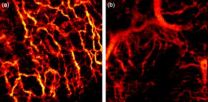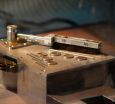(Press-News.org) Glass is strong enough for so much: windshields, buildings and many other things that need to handle high stress without breaking. But scientists wholook at the structure of glass strictly by the numbers believe some of the latest methods from the microelectronics and nanotechnology industry could produceglass that's about twice as strong as the best available today.
Rice University chemist Peter Wolynes is one of them. Wolynes and Rice graduate student Apiwat Wisitsorasak determined in a new study that a process called chemical vapor deposition, which is used industrially to make thin films, could yield a glass that withstands tremendous stress without breaking.
Wolynes, a senior scientist with the Center for Theoretical Biological Physics at Rice's BioScience Research Collaborative, and Wisitsorasak reported their results this week in the Proceedings of the National Academy of Sciences. Their calculations were based on a modified version of a groundbreaking mathematical model that Wolynes first created to answer a decades-old conundrum about how glass forms. With the modifications, Wolynes' theory can now predict the ultimate strength of any glass, including the common varieties made from silica and more exotic types made of polymers and metals.
If metal glass sounds odd, blame it on the molecules inside. Glass is unique because of its molecular structure. It freezes into a rigid form when cooled. But unlike ice, in which water molecules take on regular crystalline patterns -- think of snowflakes -- the molecules in glass are suspended randomly, just as they were as a liquid, with no particular pattern. The strong bonds that form between these randomly-arrayed individual molecules are what hold the glass together and ultimately determine its strength.
All glasses share the ability to handle a great deal of strain before giving way, sometimes explosively. Exactly how much strain a glass can handle is determined by how much energy it can absorb before its intrinsic elastic qualities reach their limitations. And that seems to be as much a property of the way the glass is manufactured as the material it's made of.
Materials scientists have long debated the physics of what occurs when glass hardens and cools. In fact, the transition is one of their last great puzzles of the field. Cooling temperatures for particular kinds of glass are well defined by centuries of experience, but Wolynes argues it may be possible to use this information to improve upon glass's ultimate strength.
The elastic properties of the finished product and the configurational energy (the positive and negative forces between the molecules) held in stasis by the "freezing" process determine how close a glass gets to the theoretical ideal -- the most stable glass possible, he said.
"The usual impression of glass is that, relative to other materials in your life, it seems easy to break," said Wolynes, Rice's Bullard-Welch Foundation Professor of Science and a professor of chemistry. "The reality is that when it's freshly made and not scratched, glass is very strong."
Wolynes, who specializes in how molecular systems move across microscopic "energy landscapes," particularly as they relate to protein folding in biology, has an interest in glass that goes back many years. His random first-order transition theory of glasses, which quantifies the molecules' kinetic properties as they cool, helped set the stage for decades of debate among theorists over how glass actually forms.
But the theory, based on work by Wolynes and collaborators that goes back to 1989, did not consider the strength of glass.
"You can come up with a theory of something and ignore one of the most practical implications because you just don't think about it," Wolynes explained.
A chance encounter with a metallurgist last year made Wolynes think again about just how strong glasscould be. "We had never worked on that kind of property, and the problem struck me as intriguing – and relatively simple in the framework of the theory we already had. We just hadn't thought to calculate it," he said.
Traditional glass is soubiquitous that people rarely think about it (until it breaks). "Even though we now have Gorilla Glass and other tempering developments, they've been developed in a somewhat Edisonian fashion," he said, noting that such hardened glasses commonly used in cell phones have a self-healing surface treatment that protects the glass itself from scratching. "Our paper is about what determines the limits on the strength of the glass, if there is no surface problem."
Wolynes noted the strength of materials has been studied since the 1920s, when Russian scientist Yakov Frenkel "calculated how strong something could be if we just take into account the direct forces between atoms. He made a simple calculation: If you have a row of atoms and pull it over another row of atoms, when would it go from one way of aligning to the next?" Wolynes said that determines a material's elastic modulus -- "how springy the material is" -- an easy concept to understand in metals that bend before they break.
"The elastic modulus is related to the thermal vibrations in the material," he said. "Basically, if you have a material that has a very high melting point, its elastic modulus is also very high. According to Frenkel, the strength should also be very high.
"That overall trend is true. That's why fighter jets are made of titanium, one the highest-meltingmetals, and low-melting aluminum, which is not as strong but lighter, is used for other things."
The theory didn't seem to relate to glasses, however. "In the early days, when people first measured the properties of glasses, they found they were easily breakable. Silica glass is very high-melting, so you'd expect it to be strong," Wolynes said. "Then they did finally figure out this was because cracks at the surface were propagating in. If they could eliminate the cracks, they would get much higher strengths."
Current metallic glasses like the Liquidmetal famously licensed by Apple for consumer electronics "come to be about a quarter of this theoretical Frenkel strength," Wolynes said. "So what is it that limits their strength? We ask whether the collective motions that go on in liquids as they're becoming glasses are the same motions that are being catalyzed when we stress the material.
"Basically, we applied our theory for what determines how the liquid rearranges as it's becoming glass. Add to that the extra driving force when you apply stress, and see what that predicts for the limit of how much it can be pushed before the atoms roll over each other" and the glass breaks, he said.
He noted the theoretical results closely match experimental ones for most materials. "The good news is, according to this theory, if you could make a material that is much closer to ideal glass – the glass you would get if you could make it infinitely slowly – then you would be able to increase its strength." That may not be possible through traditional cooling of silica, metal and polymer glasses, which Wolynes' and Wisitsorasak's calculations indicate are approaching their limits.
But it might be possible through vapor deposition of atoms, akin to the chemical vapor deposition process used in microelectronics and nanotechnology to make thin films. "It would require tuning the deposition rate to the liquid/glass transition properties," he said.
"Our theory says the best you can do with this is get about halfway to ideal glass," which he said some experimentalists have demonstrated. "It's possible there's some loophole we don't yet see that will let us get even closer to the ideal," Wolynes said. "But at least, at this point, we can get halfway there. That means it would be possible, in principle, to get glass with at least twice the intrinsic strength of current glasses."
Wolynes' theory comes with a caveat, though. Glass hardened even to the point of near indestructibility can still be destroyed, and with dramatic effect. "If you could have something infinitely strong, then you'd never need to worry about it," he said. "But there's a little bit of a problem if you make something that's very strong but can eventually break. It contains a huge amount of energy, so when it breaks, it fails catastrophically."
###This news release can be found online at news.rice.edu.
Read the abstract at http://www.pnas.org/content/early/2012/09/12/1214130109.abstract
Follow Rice News and Media Relations via Twitter @RiceUNews
Related Materials:
Center for Theoretical Biological Physics: http://ctbp.rice.edu/
Peter Wolynes bio: http://chemistry.rice.edu/FacultyDetail.aspx?p=ACC7DC090095C11C
Images for download:
http://news.rice.edu/wp-content/uploads/2012/09/Wolynes-web.jpg
Peter Wolynes
http://news.rice.edu/wp-content/uploads/2012/09/GLASS-2-WEB.jpg
Glass is strong but shows potential to be stronger, according totheoretical work by researchers at Rice University.
Located on a 300-acre forested campus in Houston, Rice University is consistently ranked among the nation's top 20 universities by U.S. News & World Report. Rice has highly respected schools of Architecture, Business, Continuing Studies, Engineering, Humanities, Music, Natural Sciences and Social Sciences and is home to the Baker Institute for Public Policy. With 3,708 undergraduates and 2,374graduate students, Rice's undergraduate student-to-faculty ratio is 6-to-1. Its residential college system builds close-knit communities and lifelong friendships, just one reason why Rice has been ranked No. 1 for best quality of life multiple times by the Princeton Review and No. 4 for "best value" among private universities by Kiplinger's Personal Finance. To read "What they're saying about Rice," go to www.rice.edu/nationalmedia/Rice.pdf.
Glass half full: Double-strength glass may be within reach
Rice University study suggests possible method for increasing the strength of glass
2012-09-24
ELSE PRESS RELEASES FROM THIS DATE:
Researchers demonstrate cheaper way to produce NFO thin films
2012-09-24
Researchers from North Carolina State University and the Georgia Institute of Technology have demonstrated a less-expensive way to create textured nickel ferrite (NFO) ceramic thin films, which can easily be scaled up to address manufacturing needs. NFO is a magnetic material that holds promise for microwave technologies and next-generation memory devices.
Specifically, this is the first time researchers have used a chemical deposition process to create NFO thin films that are "textured" – meaning they have an aligned crystalline structure. Arraying the crystalline structure ...
3-year, 676-child trial shows effectiveness of low-cost intervention to improve sun protection
2012-09-24
A blistering sunburn during childhood or adolescence more than doubles the adult risk of skin cancer. The accumulation of long-term sun exposure may be equally dangerous. A study from the Colorado School of Public Health and the University of Colorado Cancer Center recently published in the American Journal of Preventive Medicine shows one way to reduce this exposure: a double-blind randomized clinical trial of mailed sun protection packets led to higher frequency of sun protective behaviors including the use of long clothing, hats, shade, sunscreen, and midday sun avoidance.
"This ...
EARTH: Bakken boom and the new Wild West
2012-09-24
Alexandria, VA – Diesel-soaked clothing, 90-hour work weeks, and the constant groaning of a multimillion-dollar oil rig towering overhead: Welcome to life in Williston, N.D., home of the United States' latest oil boom. In this month's issue of EARTH Magazine, R. Tyler Powers, a young geologist thrust into the middle of the new boomtown, offers his perspective on what life is like today in the new Wild West.
Thousands of oil rigs sit atop the Bakken Formation, a Late Devonian to Early Mississippian rock formation that underlies parts of Montana, North Dakota, Saskatchewan ...
Tissues tell the tale: Non-invasive optical technique detects cancer by looking under the skin
2012-09-24
VIDEO:
This is a 2x2x2mm extracted blood vessel structure of basal cell carcinoma in vivo exhibiting a chaotic vascular pattern (left). Virtually cut volume obtained with OCT displaying the embedded blood...
Click here for more information.
WASHINGTON, Sept. 24, 2012—The trained eye of a dermatologist can identify many types of skin lesions, but human sight only goes so far. Now an international team of researchers has developed an advanced optics system to noninvasively ...
Heritability of avoidant and dependent personality disorder traits
2012-09-24
A new twin study from the Norwegian Institute of Public Health shows that the heritability of avoidant and dependent personality disorder traits might be higher than previously reported. People with avoidant personality disorder are often anxious in the company of others, while people with dependent personality disorder feel more secure.
Results from previous studies indicate that genetic factors explain about one third of the individual differences in these personality disorder traits, while the remaining variation is best explained by environmental influences. These ...
Newly discovered molecule could deliver drugs to treat diseases
2012-09-24
MANHATTAN, Kan. -- Kansas State University researchers have discovered a molecule that may be capable of delivering drugs inside the body to treat diseases.
For the first time, researchers have designed and created a membrane-bounded vesicle formed entirely of peptides -- molecules made up of amino acids, the building blocks of protein. The membrane could serve as a new drug delivery system to safely treat cancer and neurodegenerative diseases.
A study led by John Tomich, professor of biochemistry at Kansas State University, has been published in the journal PLOS ONE ...
A windshield wiper for Mars dust is developed
2012-09-24
This press release is available in Spanish.
VIDEO:
A team of researchers at Universidad Carlos III in Madrid has developed a device that works as a windshield wiper to eliminate Mars dust from the sensors on the NASA...
Click here for more information.
Leading energy scientists from the UK and China are joining forces to develop green technology that will revolutionise the way electricity ...
Gas outlets off Spitsbergen are no new phenomenon
2012-09-24
Frequent storms and sub-zero temperatures – nature drove the marine researchers that were assessing gas outlets on the sea bed off the coast of Spitsbergen for four and a half weeks to their limits. Nevertheless the participants were very pleased when they returned: "We were able to gather many samples and data in the affected area. With the submersible JAGO we even managed to form an impression of the sea bed and the gas vents" summarised the chief scientist Professor Dr. Christian Berndt from GEOMAR | Helmholtz Centre for Ocean Research Kiel.
The reason for the expedition ...
Therapeutic impact of cell transplantation aided by magnetic factor
2012-09-24
Putnam Valley, NY. (Sept. 24, 2012) – Two studies in the current issue of Cell Transplantation (21:6), now freely available on-line at http://www.ingentaconnect.com/content/cog/ct/, demonstrate how the use of magnetic particles are a factor that can positively impact on the targeted delivery of transplanted stem cells and to also provide better cell retention.
A research team from the University of British Columbia used focused magnetic stem cell targeting to improve the delivery and transport of mensenchymal stem cells to the retinas of test rats while researchers from ...
In birds' development, researchers find diversity by the peck
2012-09-24
Cambridge, Mass. - September 24, 2012 - It has long been known that diversity of form and function in birds' specialized beaks is abundant. Charles Darwin famously studied the finches on the Galapagos Islands, tying the morphology (shape) of various species' beaks to the types of seeds they ate. In 2010, a team of Harvard biologists and applied mathematicians showed that Darwin's finches all actually shared the same developmental pathways, using the same gene products, controlling just size and curvature, to create 14 very different beaks.
Now, expanding that work to ...
LAST 30 PRESS RELEASES:
Making lighter work of calculating fluid and heat flow
Normalizing blood sugar can halve heart attack risk
Lowering blood sugar cuts heart attack risk in people with prediabetes
Study links genetic variants to risk of blinding eye disease in premature infants
Non-opioid ‘pain sponge’ therapy halts cartilage degeneration and relieves chronic pain
AI can pick up cultural values by mimicking how kids learn
China’s ecological redlines offer fast track to 30 x 30 global conservation goal
Invisible indoor threats: emerging household contaminants and their growing risks to human health
Adding antibody treatment to chemo boosts outcomes for children with rare cancer
Germline pathogenic variants among women without a history of breast cancer
Tanning beds triple melanoma risk, potentially causing broad DNA damage
Unique bond identified as key to viral infection speed
Indoor tanning makes youthful skin much older on a genetic level
Mouse model sheds new light on the causes and potential solutions to human GI problems linked to muscular dystrophy
The Journal of Nuclear Medicine ahead-of-print tip sheet: December 12, 2025
Smarter tools for peering into the microscopic world
Applications open for funding to conduct research in the Kinsey Institute archives
Global measure underestimates the severity of food insecurity
Child survivors of critical illness are missing out on timely follow up care
Risk-based vs annual breast cancer screening / the WISDOM randomized clinical trial
University of Toronto launches Electric Vehicle Innovation Ontario to accelerate advanced EV technologies and build Canada’s innovation advantage
Early relapse predicts poor outcomes in aggressive blood cancer
American College of Lifestyle Medicine applauds two CMS models aligned with lifestyle medicine practice and reimbursement
Clinical trial finds cannabis use not a barrier to quitting nicotine vaping
Supplemental nutrition assistance program policies and food insecurity
Switching immune cells to “night mode” could limit damage after a heart attack, study suggests
URI-based Global RIghts Project report spotlights continued troubling trends in worldwide inhumane treatment
Neutrophils are less aggressive at night, explaining why nighttime heart attacks cause less damage than daytime events
Menopausal hormone therapy may not pose breast cancer risk for women with BRCA mutations
Mobile health tool may improve quality of life for adolescent and young adult breast cancer survivors
[Press-News.org] Glass half full: Double-strength glass may be within reachRice University study suggests possible method for increasing the strength of glass


